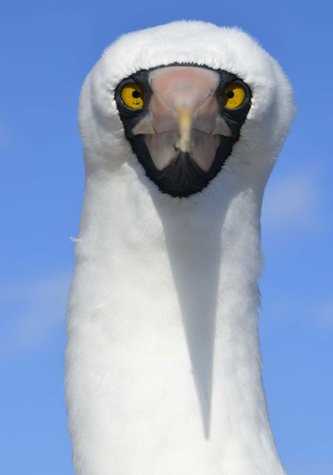The mist of the morning touches our faces while we do our stretching session on the sundeck of our ship. At the end the sun started to win the battle and finally our day became warm and nice. It is very common weather during the dry season in Galapagos, which goes from June to November.
Today is our first full day on the islands and we are ready to discover and explore Española Island, formerly known as Hood. In the morning we visited Gardner Bay and many options were offered to our guests. First the exploration of the underwater by deep water snorkel, discovery of the shores by kayak, or strolling along a dazzling white beach among dozens of resting and cavorting sea lions.
Guests that went to snorkel came back with tons of stories, about the sea lions they saw and played with, sharks, multicolored fish, rays, and sea stars. They were also commenting how clear the water is here in Galapagos. Gardner Bay has turquoise blue water and is always a great place to snorkel.
Along the coast our kayakers had a lot of fun; they observed a wide variety of sea birds such as herons, blue footed boobies, Nazca boobies, pelican and frigates. Also they saw some sea lions and turtles sticking their heads out of the water.
The walk on the beach was fabulous, now is the time where you see many sea lion pups, playing at “nursery pools.”
The curious mockingbirds are always marauding around our guests’ stuff, and some pelicans were plunge-diving for food.
Later in the afternoon we visited another part of the island, Punta Suarez, one of the richest wildlife locations in Galapagos. Right at the disembarkation point, we were greeted by many marine iguanas and by sea lions, some of them pups of only a few days old. Further along the trail we saw the unique and endemic species of Mockingbird, lava lizards and doves, as well as three different species of Darwin finches. The trail took us inland where there was a combination of native and endemic species of plants, all of them grey and very dry, since we are at the end of the dry and cold season, named “garua” season. While admiring these unique species, soon we arrived to the nesting site of blue footed boobies, some of them with little babies. Further along the cliff the Nazca boobies were in their mating ceremonies and at the end, the waved albatrosses exceeded our expectations. We found many young ones that were showing their juvenile plumage and their desire to fly. Some adults were displaying their last courting rituals, which very often assure the next breeding season with the same partner. Every year the entire population of these birds, around 28,000, arrives to Española Island by mid-March to start their breeding cycle. They leave the Island by the end of December or beginning of January when they go to the coasts of Chile and Peru to their feeding grounds. These magnificent birds display one of the most spectacular courtship rituals among sea birds, and today we were lucky enough to see few couples engaged of this ritual.
Galapagos hawks, frigates and red billed tropic birds were along the trail that took us to the famous blowhole and then further into the open plateau of the island where hundreds of these birds nest.
The trail was the most arduous one of the week, lot of boulders, but the rewards were many, around six pm we came back to the National Geographic Endeavour, very pleased to have had a wonderful time in these pristine islands called Galapagos.









